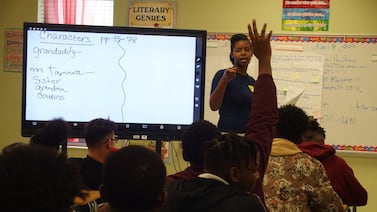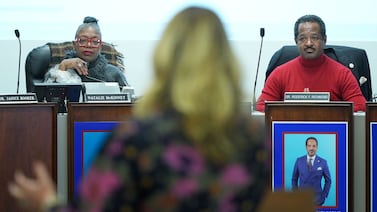Sign up for Chalkbeat New York’s free daily newsletter to get essential news about NYC’s public schools delivered to your inbox.
As Mayor-elect Zohran Mamdani figures out how to deliver on his promise of universal child care, his administration is grappling with what lessons to draw from the expansion of universal prekindergarten and 3-K.
In many ways, the rollout of universal pre-K under former Mayor Bill de Blasio offers a clear template for Mamdani — an ambitious and fast-moving effort that “showcased the ability of city government to actually meet the needs of New Yorkers,” as Mamdani said in June.
But many child care providers still feel resentful about how the program rolled out a decade ago, saying it unleashed disruptions to the system that persist to this day. Some of those providers are now urging Mamdani’s campaign to slow down and avoid some of those same pitfalls.
“Members of the provider community have strong feelings about what worked well and what didn’t during the first expansion,” said Xanthe Jory, a former top official overseeing child care expansion in the city Education Department under de Blasio. “They will have important questions about what will be different this time around. The success of another expansion will depend, in part, on the degree to which their concerns are addressed.”
It’s a balancing act that will shape how Mamdani approaches perhaps his most ambitious and complex campaign promise: providing free, universal child care for kids as young as 6 weeks old.
And the stakes are high. Families with young children continue to leave the city at an alarming rate due in part to ballooning child care costs. At the same time, any major changes Mamdani makes will send ripple effects across the city’s sprawling child care ecosystem, which relies on thousands of independent child care providers.
Mamdani’s campaign is seeking advice from people on different sides of the issue.
Former de Blasio budget chief and deputy mayor Melanie Hartzog, who played a key role in the prekindergarten expansion, is co-chairing Mamdani’s transition committee. Emmy Liss, the former chief of staff for Josh Wallack, a top de Blasio aide who oversaw the pre-K rollout in the city Education Department, has also been advising the campaign on child care, according to multiple people familiar with the conversations. (Liss declined to comment on her involvement, and Mamdani’s campaign didn’t respond to an inquiry.)
Observers and people involved with that effort say there’s much Mamdani’s campaign can learn from it — including the sense of urgency and speed with which officials approached the rollout.
“We can’t take too long, because then people lose hope, it doesn’t actually benefit people, and then it has the risk of getting deprioritized,” said Rebecca Bailin, the executive director of New Yorkers United for Childcare, a parent advocacy group.
But others say de Blasio’s administration failed to account for the collateral damage the rapid expansion would bring to existing child care providers, causing staff to flee and some programs to shutter.
“There was such a push to move forward that, in many cases, the providers were left behind,” said Laura Ensler, the founder of an early childhood program in Brooklyn’s Brownsville neighborhood who has known Mamdani for years and has also been advising his campaign. “We had a lot to offer and there weren’t many opportunities to share our experiences because they were moving so quickly.”
Now, as Ensler offers advice to Mamdani’s team about crafting its plan to reach universal child care, she is urging them to take their time.
“We know we want to act fast on everything that Zohran has put out there,” Ensler said. “And I’m one of the people that will say, look at every perspective of what you’re doing before you commit, because people will be hurt if you don’t.”
A need for speed
After de Blasio took office in 2014, it took just 18 months for his administration to stand up tens of thousands of pre-K seats, an all-hands-on-deck blitz that involved everything from marketing the new program to completing building inspections.
Some staffers who worked on the effort said that speed was key: People needed to experience the program in order to build the long-term support to keep it going.
“There was a clear political window, and a mayor who was willing to match that window with resources and focus. You can only maintain that level of political focus for so long,” said Liss. “Building pre-K quickly built the political coalition in many ways to sustain the program.”
Some observers say Mamdani may be stepping into an even more opportune political window. Gov. Kathy Hochul, who endorsed Mamdani after the June primary, has signaled that she shares the goal of universal child care as a top priority.
“The stars have really aligned in a big way around this issue,” said Grace Rauh, the executive director of the 5Boro Institute at Citizens Union.
A lesson in unintended consequences
For some child care providers and advocates, de Blasio’s much-heralded pre-K programs left a complicated legacy. Teachers at programs run by city public schools earned much more than those in city-funded programs run by private providers, setting off a mass exodus of staffers from private programs.
Many smaller home-based providers said they weren’t included in the initial rollout of city-funded contracts — and lost many of their students to the new programs.
“I can tell you that we lost many, many qualified child care providers as a result, and I truly believe that further enhanced the child care deserts that we currently have,” said Tammie Miller, the chapter chair for thousands of home-based providers represented by the United Federation of Teachers.
Membership in Miller’s unit has shrunk from 28,000 providers in 2007 to just 12,000 today, she said.
And despite its claims of universality, the program has failed to include many children with disabilities, who require more expensive programs and specialized staff. As recently as last year, hundreds of preschoolers with disabilities couldn’t access free 3-K and pre-K seats.
“It is essential for the administration to consider the needs of children with disabilities at the outset,” said Randi Levine, the policy director at Advocates for Children. “It’s much harder to add something on later.”
Advocates and former officials said they hope the Mamdani administration takes heed of some of those lessons and builds them into its approach from the start.
Liss said the system’s exclusion of home-based providers and students with disabilities are two of the clearest lessons she’s drawn from the rollout — ones she hopes “a new team could take and think differently for the future.”
Other veterans of the pre-K effort said that while it’s still important to move quickly, slowing down when needed could help the next administration avoid further destabilizing an already fragile system.
“Maybe instead of 90 miles an hour, let’s go 80,” said Jory, the former Education Department official. “I think that even letting the foot off the gas a little bit would allow for some really thoughtful work that will support the system long term.”
Michael Elsen-Rooney is a reporter for Chalkbeat New York, covering NYC public schools. Contact Michael at melsen-rooney@chalkbeat.org






